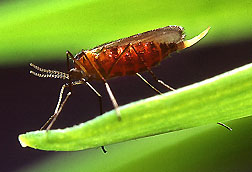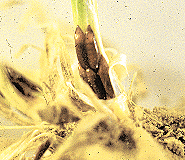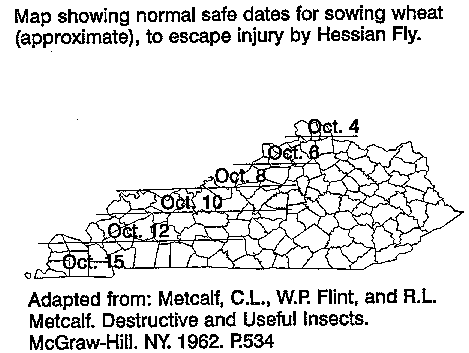Hessian Fly in Kentucky
ENTFACT-101: Hessian Fly in Kentucky | Download PDF
by Doug Johnson, Extension Entomologist
University of Kentucky College of Agriculture
Over the years, Kentucky has experienced sporadic outbreaks of hessian fly, Mayetiola destructor (Say). Though this pest is not of major concern, it remains a potential threat, especially as:
- wheat production moves south,
- we develop new high yielding varieties that do not contain resistance, and
- the process of no-till double cropping increases in acreage.
- Planting date, straw destruction and plant resistance have been the main stay for controlling this pest. In Kentucky, production systems have been moving away from these practices.
One major factor that increases potential for blister beetle problems is crimping hay. This crushes the beetles and leaves them in the hay where they can be eaten by animals. The second factor is a large increase in grasshopper numbers. The larval stages of these blister beetles develop on grasshopper egg pods in the soil. This generally results in increased blister beetle numbers, which in turn increases the potential for hay contamination.

Adult Hessian Fly
Description and Biology
The hessian fly adult is a small fragile fly, sooty black in color (abdomen of the female is a dull red) and smaller than the common house mosquito. Eggs are reddish in color and are laid in lines of 10 or twelve in grooves on the upper side of leaves.
The immature are white legless maggots. These maggots work their way down the groves in leaves as far as they can go behind the leaf sheath. Here they rasp on the stem and suck up the sap that oozes from the wound. They do not move once feeding has begun.

"Flax Seed" Stage of the Hessian Fly
After about two weeks of feeding their outer skin loosens, turns brown and hardens forming the protective case often called the "flax seed". It is this stage that is most often seen by producers and scouts. Out of this "flax seed" emerges the adult to begin the cycle over again.
Life Cycle
The hessian fly has two generations per year. In Kentucky we are mainly interested in the fall one, however the spring generation may occasionally cause problems, and can definitely allow build-up of the pest.
The adults are out in September and early October mating and laying eggs. Larval activity will last through October, but damage may not be evident until the plants are winter stressed. From late October until spring the "flax seed" stage protects the overwintering hessian fly.
About March, adults emerge, mate and begin to lay eggs. Adult, egg and maggot activity will go through May. At this time the "flax seed" will form and the hessian fly will over summer.
Damage
Hessian fly feeding damages the stem and reduces plant vigor. The result is weak and stunted plants, which may die in the winter. Spring damage is similar except that plants may produce a "spindly" stalk that breaks easily, rather than die.
Scouting
Look for areas of poor stand and stunted plants. Examine the base of several plants by pulling back the sheaths of several leaves, and look for the "flax seed".
Biotypes and Resistant Varieties
The use of resistant wheat varieties was an early and relatively successful response to control this pest. Unfortunately, hessian fly populations seem to adapt to resistance by producing new "biotypes". These biotypes currently, sixteen of them, are able to feed on the various resistant varieties. These biotypes are identified by the letter A through O and GP (Great Plains) which was the first biotype described.
In 1988 scientists from the USDA-ARS Hessian Fly Laboratory conducted a survey to determine what biotypes were common in wheat growing areas. In Kentucky samples were taken from Calloway, Christian, Daviess, Fulton, Hancock, Logan, McCracken and Warren counties. From these surveys the biotypes B,D,G,J,L,M, and O were detected. However, "L" was by far the most common biotype making up, on average, 94.5% of the samples. Unfortunately, there are no currently used resistant varieties which biotype "L" cannot feed and reproduce on. Even though there is no variety that has direct resistance to biotype "L", it is still a good practice to use varieties with known hessian fly resistance. This is because it is more difficult for hessian fly to reproduce on any resistant variety than on a susceptible host.
Prevention Practices
Most hessian fly problems can be avoided by using a few simple agronomic practices. Once an infestation has developed, there is no rescue treatment.
Good Production Practices
- Plant production wheat after the fly free date
- Do not use wheat or barley as a cover crop if planted before the fly free date
- Use Kentucky Certified Seed or equivalent varieties--Pay special attention to standability
- Avoid agronomic practices which would reduce standability, eg. excess nitrogen fertilization, heavy seeding rates
- Maintain good balanced fertility; a strong plant will overcome a light infestation
- Keep down growth of volunteer wheat
Good Ideas that will NOT work:
- Pasturing wheat with cattle or sheep
- Rolling wheat to crush the maggots or puparia
- Mowing wheat in the spring
- Early planting of wheat strips as trap crops
- Burning wheat stubble after harvest.
In general, these efforts are aimed at destroying the "flax seed" stage. However, the flax seed is usually so low on the crown of the plant that these techniques will not reach most of them.
Hessian fly problems can be reduced to insignificance by delay of planting until after the "hessian fly free" date. Below you will find a map illustrating the "hessian fly free" dates for Kentucky. Do not accept the dividing lines as absolute but, rather use them as a guide to target a wheat planting window.

Hessian Fly in Kentucky Map
Additionally you may need to modify these dates by one to several days based on the current fall weather. A warm frost free fall would call for later planting while a cool fall with early frost might allow planting a few days earlier.
CAUTION: These dates should not be used in the east central, and mountain counties of Kentucky, USA. In those areas with widely divergent temperature patterns, planting within 10 days to 2 weeks of the 50% chance of first killing frost will aid in control of hessian fly.
Revised: 8/93
CAUTION! Pesticide recommendations in this publication are registered for use in Kentucky, USA ONLY! The use of some products may not be legal in your state or country. Please check with your local county agent or regulatory official before using any pesticide mentioned in this publication.
Of course, ALWAYS READ AND FOLLOW LABEL DIRECTIONS FOR SAFE USE OF ANY PESTICIDE!
Photos courtesy S. Bauer, ARS/USDA and Univ. of Kentucky IPM Training Slide Set
